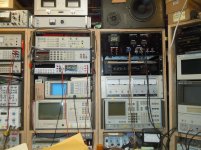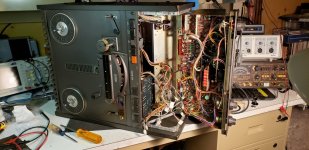Speaking of probes, which some were, I was recently given a function generator and oscilloscope. The scope has one probe and the generator, none. Any good sources of replacements apart from OEM? I live in BC Canada.Regards John L.
The scope has one probe and the generator, none.
Any good sources of replacements
Pomona has good BNC or banana cables, and adapters, see Digikey, etc.
Don't cheap out on these, they'll last for decades.
Here is a decent generic scope probe:
CS1001 Analog Probe ($49.00) : Saelig Online Store
Last edited:
I'll check it out.
Remember that an attenuator probe sets a limit on the useful scope bandwidth, unless it goes several times higher.
The generator will be 50Ω output impedence, so just use coax with BNC connectors.
Don’t skimp on the probes for the oscilloscope. Ideally you want probes with 3-5 times the bandwidth of the CRO, or else the probe will cause additional rolloff at high frequencies.
Lots of CROs use additional contacts around the probe for ID, so unless you use the right probe you’ll get the wrong divisor.
Don’t skimp on the probes for the oscilloscope. Ideally you want probes with 3-5 times the bandwidth of the CRO, or else the probe will cause additional rolloff at high frequencies.
Lots of CROs use additional contacts around the probe for ID, so unless you use the right probe you’ll get the wrong divisor.
Partial good news! We found the other 'scope probe. Just need signal gen's probes now. Thanks for the advise folks. BTW, I'll also look into making my own SG probes. I hadn't thought of that earlier.
Regards John L.
Regards John L.
Last edited:
This is my messy bench. Things definitely get built and tested on it on a regular basis, but I am currently between projects. Some things not seen are AVO and Hickok tube testers, a Lambda supply and a uTracer 3+.
The focus is completely audio..
Wow! A RTX6001 !
Remember that an attenuator probe sets a limit on the useful scope bandwidth, unless it goes several times higher.
Are you saying a 200MHz probe isn't matched to a 200MHz 'scope?
Are you saying a 200MHz probe isn't matched to a 200MHz 'scope?
Exactly. The probes should be several times higher in bandwidth [and cost] to get [nearly] the full scope bandwidth.
This is a little detail that the scope mfrs don't usually mention. A ''200 MHz'' probe description means that the
probe itself has a bandwidth of 200MHz.
If you cascade two equal, buffered RC filters, the corner is lower in frequency. I'd use 500MHz probes with
a 200MHz scope, at a minimum, if you need the full 200MHz bandwidth.
Last edited:
Hi diyralf,
If you look lower right, you can see one peeking out from around a black Simpson 260 meter. Directly below the HP 3585A Spec-an.
They do tend to lurk!
-Chris
They exist around here.Wow! A RTX6001 !
If you look lower right, you can see one peeking out from around a black Simpson 260 meter. Directly below the HP 3585A Spec-an.
They do tend to lurk!
-Chris
Attachments
Success! I guess it is no longer on my workbench. Velodyne DD12 amp repair with upgraded caps. Album below.


Ah, that's useful, I'd not realized they weren't usable BW figures - so a 200MHz probe would be a suitable choice for 100MHz 'scope to make full use of the bandwidth?Exactly. The probes should be several times higher in bandwidth [and cost] to get [nearly] the full scope bandwidth.
This is a little detail that the scope mfrs don't usually mention. A ''200 MHz'' probe description means that the
probe itself has a bandwidth of 200MHz.
If you cascade two equal, buffered RC filters, the corner is lower in frequency. I'd use 500MHz probes with
a 200MHz scope, at a minimum, if you need the full 200MHz bandwidth.
Then again I use the probes that came with the 'scope, and they seem flat to the limit of the 'scope judging by the rectangularity of fast logic waveforms.
My nice B&K Precision 878 LCR meter just arrived.
It's a lovely instrument. After a quick open cal I'm able to measure small capacitors reliably to a precision of 0.1pF, which is something I've never been able to do at home before (my Fluke 87 runs out at 10pF).
I'm really liking the spring-loaded slots for sticking leaded components into. It works well with my fixture for testing MELF and chip parts too, having a pair of banana jacks.
Sure, at 4 digits and ~1% on capacitance it's not as accurate as the newer 880 (4 3/4 digit and 0.1% accuracy), but it's plenty good enough for my needs.
It's a lovely instrument. After a quick open cal I'm able to measure small capacitors reliably to a precision of 0.1pF, which is something I've never been able to do at home before (my Fluke 87 runs out at 10pF).
I'm really liking the spring-loaded slots for sticking leaded components into. It works well with my fixture for testing MELF and chip parts too, having a pair of banana jacks.
Sure, at 4 digits and ~1% on capacitance it's not as accurate as the newer 880 (4 3/4 digit and 0.1% accuracy), but it's plenty good enough for my needs.
Attachments
Ah, that's useful, I'd not realized they weren't usable BW figures - so a 200MHz probe would be a suitable choice for 100MHz 'scope to make full use of the bandwidth?
Then again I use the probes that came with the 'scope, and they seem flat to the limit of the 'scope judging by the rectangularity of fast logic waveforms.
It sorta depends on what you're trying to measure. A 100 MHz probe will work at 100 MHz on a 100 MHz oscilloscope, but the amplitude will be out, and it depends on how you've adjusted the trimmer cap in the probe. If you're only interested in seeing that a signal is there or not, that's fine. If you care about reliably measuring amplitudes, then no.
Going with probes that are significantly wider bandwidth than your oscilloscope means this is progressively less of an issue. I use P6106A probes (250 MHz) on my TDS340A CRO (100 MHz) and that works pretty well.
There is one on my bench as well, not quite as well hidden as Chris's.
The machine in front of it is my 1982 Otari MX-5050BII-2 which was just completing another phase of overhaul + modifications.
Love the Otari reel deck. We had one of these when I was a child, then later an Akai cross-field deck. I remember recording my new love over gold LP onto tape at 7.5 IPS, then packing away the LP and only listening to the reel. Of course I subsequently lost the LP that I was trying so hard to keep pristine, but you get that when you're a kid.
so a 200MHz probe would be a suitable choice for 100MHz 'scope
to make full use of the bandwidth?
It's certainly better than a 100MHz probe with a 100MHz scope.
Hi Suzy,
I have two of them, the other is a MKIII-2 which is a little further along on the mods front, and I think sounds a bit better. These machines were gifted to me by various people over the past few months, they represent a sizeable investment in time, money and sweat equity.. LOL
Back in my teens I had a Hitachi cassette deck and an Oki-Denki R2R which ran at 7.5ips on a good day, and mostly didn't. (2 head single motor)
The RTX-6001 on my bench was part of the diyA group buy like Chris's, probably one of the best deals I have ever gotten on a piece of test equipment.
I have two of them, the other is a MKIII-2 which is a little further along on the mods front, and I think sounds a bit better. These machines were gifted to me by various people over the past few months, they represent a sizeable investment in time, money and sweat equity.. LOL
Back in my teens I had a Hitachi cassette deck and an Oki-Denki R2R which ran at 7.5ips on a good day, and mostly didn't. (2 head single motor)
The RTX-6001 on my bench was part of the diyA group buy like Chris's, probably one of the best deals I have ever gotten on a piece of test equipment.
My nice B&K Precision 878 LCR meter just arrived.
It's a lovely instrument. After a quick open cal I'm able to measure small capacitors reliably to a precision of 0.1pF, which is something I've never been able to do at home before (my Fluke 87 runs out at 10pF).
I'm really liking the spring-loaded slots for sticking leaded components into. It works well with my fixture for testing MELF and chip parts too, having a pair of banana jacks.
Sure, at 4 digits and ~1% on capacitance it's not as accurate as the newer 880 (4 3/4 digit and 0.1% accuracy), but it's plenty good enough for my needs.
Looks great, I have an Agilent U1732B which works rather well compared to its predecessors. I am not sure what the minimum capacitance is that I can measure reliably but it doesn't have problems with 100pF 2% caps and above so far.
- Home
- Design & Build
- Equipment & Tools
- What's on your workbench???


